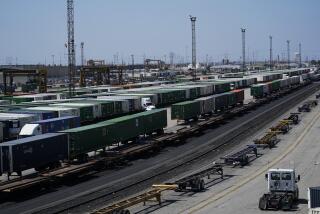More Restrictions on Board for Van Nuys?
- Share via
Resurrecting a years-long battle between airplane operators and other businesses that rely on the world’s busiest general aviation airport and residents who live around it, Los Angeles officials moved on Monday to consider additional restrictions on noisy commercial and charter jets at Van Nuys Airport.
The city’s Airport Commission asked staff members to study how to phase out jets built between 1965 and 1987 that generate much of the noise over communities ringing the San Fernando Valley facility. Residents have lobbied for years to get rid of these planes, which they say routinely disrupt telephone conversations and backyard barbecues.
The city of Los Angeles operates Van Nuys Airport as well as Los Angeles and Ontario international airports and Palmdale Regional Airport. The 730-acre Van Nuys facility is home to more than 100 businesses that include six major fixed-base operators and numerous aviation service companies.
The commission is already studying measures to restrict what are known as Stage 2 jets through a complex federal process. The effort isn’t expected to be completed until early 2009.
That $3-million study also includes other measures to limit noise at Van Nuys Airport, such as banning all nighttime operations and capping or phasing out helicopter flights. It represents the first time a U.S. airport has attempted to implement multiple noise and access restrictions.
Following through on a promise by Mayor Antonio Villaraigosa to limit noisy jet operations at Van Nuys, the appointed commissioners said they wanted to pursue both federal and local studies in the hope they could impose restrictions more quickly. Councilmen Tony Cardenas and Jack Weiss, who represent areas affected by jet noise, also support the proposed phase-out of Stage 2 jets discussed by airport commissioners Monday.
The Federal Aviation Administration must sign off on any restrictions and has not looked favorably on such measures in the past. A federal law enacted in 1990 prohibits airport operators from limiting operations or imposing noise restrictions. Los Angeles officials hope to circumvent that by reinstating a resolution passed by the City Council in early 1990 that proposed phasing out loud jets over a seven-year period.
Residents hope the new study, which would target about one-fifth of the aircraft based at Van Nuys, will take less time than the federal process.
“I came to the Valley in 1953 looking for peace and tranquillity, but now many of us cannot sit on our patios and have a conversation,” Lake Balboa resident Bill Mouzis told airport commissioners. “Never again can we allow the interests of the airport business community to supersede those of residents.”
Business owners said they would fight any restrictions.
“Since 1981, business operators at Van Nuys Airport have faced the imposition of 19 business-constraining measures that have diminished both revenues and jobs at one of the Valley’s most significant economic engines,” Robert L. Rodine, a consultant to businesses at the airport and co-chair of the aviation committee for the Valley Industry and Commerce Assn., wrote in a letter to airport officials. “The economic significance of the measures to both business and the city, as lost tax revenues, is enormous.”
Airport officials said they have already measurably reduced noise at Van Nuys through a nighttime departure curfew and a voluntary program that records jets taking off from the airport in an effort to identify noisy operations.
The City Council also approved an ordinance in 2000 that limits businesses at the airport from replacing noisy jets with similar models.
Since then, the number of jet operations by noisy planes has fallen 37%, from 10,623 in 1999 to 6,665 last year, said Selena Birk, airport manager at Van Nuys. These jets constitute about 15% of the total aircraft operations at the facility.
Airport businesses say these restrictions are enough to keep noise under control at Van Nuys and that additional regulations will force them to lay off workers. Clay Lacy Aviation, which has been in business at the airport since 1963, said it would not be able to afford to replace 10 Stage 2 aircraft if new rules prohibited their use.
“If these rules are adopted and we lose 10 aircraft, 60 middle-class families will be unemployed,” Robert “Duke” Tonry, the firm’s director of air medical operations, told airport commissioners. Lacy’s 10 Stage 2 aircraft are used for public service efforts, he added, including medical transport.
More to Read
Sign up for Essential California
The most important California stories and recommendations in your inbox every morning.
You may occasionally receive promotional content from the Los Angeles Times.










